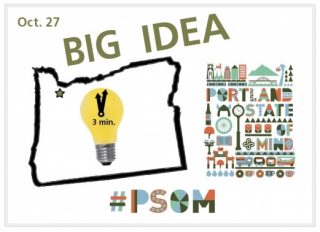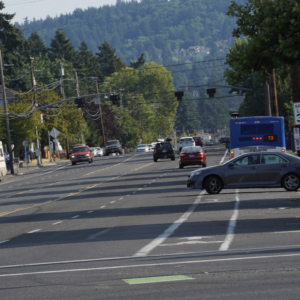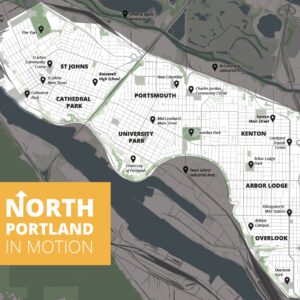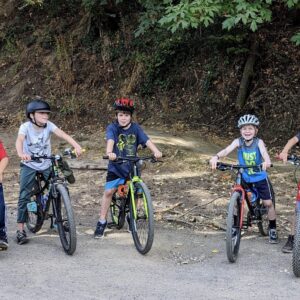Stagnation got you down?
Tired of over-compromised projects that don’t move the needle?
Looking for exciting transportation projects you can really sink your teeth into?
Than we’ve got an event for you!
The Oregon Transportation Research and Education Consortium (OTREC) is hosting Let’s be Fearless: Big Ideas for our Transportation Future on October 27th.
Here’s what it’s all about:
Portland is often considered the leader in progressive multi-modal transportation systems but we’re being rapidly outpaced by competitors such as Minneapolis, Chicago and New York City. Now is the time to think big and get creative if we’re going to continue our place as a transportation leader.
[Sort of reminds me of the Big Ideas contest we did back in 2010.]
The event will be held on Portland State University’s campus and will feature 15 of “Portland’s brightest minds and engaging personalities,” who will compete for your attention by selling their big idea for the future of Portland’s transportation system in three minutes or less.
Advertisement
Event organizer Susan Peithman is assembling an intriguing list of presenters. The list so far includes: urban planner Nick Falbo, the man behind the “protected intersection” design (and much more); Kelly Clifton, the researcher who has helped us understand the connection between mode choice and shopping habits; Sarah Mirk, the former Portland Mercury reporter turned author and online editor of Bitch Magazine; Chris Distefano, a veteran bicycle industry PR and marketing expert who now works for Rapha Performance Roadwear; and others.
Peithman says the goal of the event is to, “Get people out of their comfort zone of what is and get them thinking about what can be.”
The event will be emceed by Steph Routh, a non-profit technology and communications consultant who wrote the book on moving-by-bike.
OTREC also plans to unveil a new name and rebranding that Peithman says will, “reflect OTREC’s evolution as Portland State’s transportation research and education center.”
If you have a big idea, Peithman is happy to consider adding you to the event. Just send a short paragraph about it to peithman@pdx.edu.
— Full event details at OTREC.us






Excellent!
My big idea: The future (like the past) will be human powered. Now to persuade PBOT and ODOT to get out of the way of that (or facilitate it, but that may be asking too much).
implementation of big idea:
starting today, do not spend a dime on transport infrastructure that is exclusively for those (still) in cars. Going forward, all funds spent must be to enhance and support bicycling and walking including enforcement of the laws that chiefly benefit those not in cars but are currently overlooked, deprioritized. To the extent that these expenditures have ancillary benefits for those (still) in cars, so be it.
no more freeway expansions
no more widening of roads
no more digital signs on I-5 telling impatient automobilists how many minutes until they get to I-205 (how much did those cost anyway? and who approved them?)
Instead lets have lots of diverters, biking and walking signals, speed limit reductions, enforcement, sharrows, bike parking expansion.
Found it!
Who is signing off on these expensive computer games on our highways? – $6.5 million artificial traffic-intelligence project?!
“Until they can scratch up the $1 billion it would take to expand congestion-plagued Oregon 217, state traffic planners say they’ll focus on making it a “smarter highway.”
In fact, in a way, it will be alive.
The next, brightly colored phase will happen later this year, when the Oregon Department of transportation flips the switch on a series of giant LED screens giving motorists estimated times to key locations and interchanges.
Meanwhile, engineers will install sensors into the looping, crash-prone interchange with U.S. 26 that will take moisture readings and flash speed advisories to drivers when the pavement is slick.
The changes coming to the 217 corridor are part of a larger $6.5 million artificial traffic-intelligence project that engineers believe will permanently alter the Portland metro area’s daily commuting culture.”
http://www.oregonlive.com/commuting/index.ssf/2013/04/odot_plans_to_raise_the_iq_of.html
Accept the unpopular fact that king car culture is destroying the essence of human and sustainable culture, including, of course, the fact that auto use is spewing out carbon molecules equivalent now of particles of mass destruction. Thus, Portland needs to plan creative and dramatic widespread impediments and discouragements to private auto ownership and usage, while seriously encouraging and facilitating, in huge ways, both protected pedestrian walkways and protected bicycle/tricycle lanes. Portland has just barely begun an authentic serious policy level of protected bicycle use everywhere in the city.
How about this tag line: “putting the ‘value’ back into value engineering”…versus the more common output of that process to compromise active transportation access and safety through cost cutting.
Require all publicly funded projects to use a life-cycle cost analysis for a 20 year time horizon that includes: first cost (design/land/construction), operation and maintenance (electricity, re-striping, upgrades, etc.), crash reduction (what’s your/your family’s safety worth?), daily delay (what’s your time worth?), daily fuel consumption (spend much on gas?), point source pollution (generated by stopped vehicles = health cost), area insurance rates (this costs more where it is less safe to drive). Each of these things, and others, can be estimated for any two choices and everyone near or using the project area will pay some portion of all of these costs.
Wait, this sounds dangerously like “hold government accountable”…
Where is it? The website just says PSU for location.
Stay tuned for details!
Make Sandy into an actual boulevard. Center median between all collector streets and replace curb parking with buffered bike lanes. Maybe a few roundabouts. Pick your favourite 4+ lane road with parking; 102nd? 122nd? Division?
This looks like a really interesting event. Is pre-registration required? I don’t see much at that link. I can see this easily growing to an entire weekend in future years.
My idea: only allow automobiles on roads heading out of town.
Repeal right-turn-on-red laws and force drivers to stop before crosswalks instead of in them. Fearless enough?
Raise gas taxes. Oh wait, that’s suicidal…
most pedestrians are killed by autos going straight or left, not right.
Killed, I can believe that. Here in SF there have been a few collisions due to drivers looking left trying to beat oncoming traffic while turning right as pedestrians have just stepped off the curb – including a cabbie who ran over and killed a kid (just like in NYC not long ago). Bottom line is people treat right turns as yields now, even though the laws clearly state “after stop”.
About fifteen minutes ago I pointed the stop line out to a driver who was blocking the crosswalk I was just walking across. He said he had no idea that (thick yellow bar several feet before the crosswalk lines) was a stop line.
But what about the interested but concerned ideas? Just kidding, this sounds like an awesome event and I’m looking forward to seeing its results.
how about fixing crash corner in Raleigh Hills?
A dymaxion future of flying cars and solar powered monorails is no more absurd than expecting significant changes to the transportation system until realistic funding is in place. Freight rail won’t share with passenger rail, cars resent sharing with cyclists, freight truckers wear down infrastructure, and the neediest can’t afford access to the system There is no mechanism to acquire funding to address any of it. Would it be the department of redundancy department to ask for a carbon tax?
Making Transportation Fun: Trails as Transportation. Wherever there is a stretch of grass, wooded area, etc. parallel to a MUP–>make a trail. Add in some interesting features (wooden bridges, “B” lines with jumps or rock gardens), and toss in a small pumptrack here and there. Imagine the possibilities along the Willamette River, Springwater, and the 205 bike path. Some of these areas even have some elevation gain and loss for some additional fun possibilities. Get kids on bikes, riding to places to ride their bikes. Get adults on bikes practicing their skills on the way to work. We have a lot of space that isn’t very useful that could turn a rather boring ride into something pretty exciting. If I had the time to do this idea justice for this event, I would. If you do, steal away. Portland could quickly go from a city where people trade in their knobbies for slicks to one that embraces off-road fun, and provides for it.
…And don’t close them at “dusk”…
We have some great new trails (paved) in my neighborhood (in Oregon’s Washington County) that I use for heavy goods transport (e.g., kids & groceries on the slow cargo bike), but they are governed by Parks, which means like all parks, they are “closed” at dusk, which comes earlier and earlier this time of year. One segment of these trails also makes a low-stress alternative “last mile” of my commute home, but this Winter I’ll be breaking the rules if I use it. My alternatives put me on either a narrow, two-lane 40-mph road with no shoulder (at night, sometimes in the rain), or attempting to make a left turn across a five-lane, 35-mph boulevard.
Big scary ideas: Be willing to assertively control the behavior of motor vehicle operators with as much coercion as is necessary to get the job done, US Constitution and bill of rights be damned. Force the cost of housing down by public policy–otherwise we will have a future of SOV commuters using Longview and Kalama as commuter suburbs for their jobs in Beaverton and Wilsonville. Fund mass transit as lavishly as we are currently willing to fund war.
– Ban “beg buttons” required to activate pedestrian (and, in some locations, bike) signals. No one should be forced to ask for permission and often WAIT an extra signal cycle to cross, just because they aren’t in a car- especially now that vehicle detectors give cars the green BEFORE they even reach the intersection. This rule would incentivize highway agencies to design intersections with shorter crossing distances — or even invent pedestrian detectors so that we get some of the privileges currently extended to drivers.
– Require all construction projects, large and small, to account for safe bike passage where bike facilities already exist. It should no longer be acceptable to cut off access through a work zone or make it dangerous for more vulnerable modes of transportation while preserving access for cars. Projects must always preserve bike lanes during construction, or provide an expedient and well-signed detour.
– Also, ban large trucks from urban centers. So much of our infrastructure is designed around the wide turning radii needed by these things, and in most cases facilities already exist around the fringes to allow the transfer of loads to smaller vehicles that can deliver more efficiently anyway. This change will be essential as our cities densify, and will lead to a much more walkable, livable, bikeable environment.
– Implement more aggressive road diets and traffic calming – EVERYWHERE. Barbur, Hawthorne, NE Broadway, you name it. Slow the traffic down to sane speeds and make it easier for non-drivers to get around safely.
– Make neighborhood greenways real. 20mph speed limits, with diverters every few blocks to limit cars to truly local traffic only.
– Post bike-system maps at all major junctions between bike routes.
– Hey TriMet! How about adding express service along the major bus routes, like other cities have? These would run on the same routes as the milk-run buses that stop every 2 blocks, but only stop every half-mile to every mile, covering the same ground as the local buses but nearly as fast as light rail for a fraction of the cost. By the way this is NOT the same thing as Bus Rapid Transit, which is far more expensive: Seattle has just added some BRT lines to their system, but for decades they’ve had express buses running side-by-side local buses on many routes.
– Yes, of course a big increase to the gas tax. That one goes in the “duh” column, same place it’s been for decades.
Extend the river-front portion of the Springwater Corridor all the way up to the Columbia and down to Eugene, with easy access to (among other places) Oregon City, Canby, Wilsonville, Newberg, Salem, Monmouth, Albany, and Corvallis.
My big idea: Make driving less convenient than ANY other transportation option for short trips and commutes.
Institute inner-city congestion pricing for autos, create safer streets that encourage biking and walking, develop reliable and comfortable mass transit.
My BIG idea is Co-existence and Multi model use;
-lets start with the 3 mile radius or short trips by bike. promoted free “park and Ride” lots/spots outside city centers (3 mile radius) for motorist to park and then Ride their/a bike the rest of the way to their destination.
– tax credits for commuting by bike, incentives to use your car less like gas credit or tax refunds. it would be easy to track and easy to set guidelines for a motorist to “sign up” for.
– rebates from the city/state for buying a bike or donating a bike to buy a new one each year. This would help the bicycle industry and promote new riders.
– Install transit centers designed like storage facilities for commuters to store a bike in a fully enclosed and secure locker along with space for gear and what not. this will promote more motorists to ride to a train station leave their bike and take the train into city centers (crossing through most of metro Portland) on a bus or lite rail especially for sporting events. This is working really well in Atlanta, Irvine Ca and out lying cities around NYC.
– Continue promoting safe riding within Portland but up the anti 10 fold, eliminate bike theft issues, employ PD representatives to patrol bike commuter routes (on bikes or electric vehicles) and problem areas promoting visibility and safety to the eye of new riders. by adding a high level of safety and protection not just by making the route safe but make new riders feel wanted and fully protected when they see PD or safety representatives all around during a ride they will feel less threatened by transients and motorists alike.
– Change the “rules of the road” promote specific times of the day for commuters to ride on major Blvd and restrict motorists from those arterial roads (by obviously offer an alternative route at those times for motorists) Start with a couple major Blvds, making the in bound lanes (towards city center) closed to motorized traffic from 7am to 9am and then out bound lanes (away from city centers) from 4pm to 6pm
This will promote more motorists to bike commute because it gives them a huge blvd closed to cars as their best and fastest option to commute. simple signage at every intersection and all red lights making every intersection a stop sign with signs saying “non motorized traffic only between these times”, heavy police/enforcement visibility during those times of day to deter motorists from jumping on the open road and if a few cars do accidentally get on the blvd at those times it will still be very safe (cars will have to stop at every light) and comfortable riding conditions for newer bike commuters.
All of these ideas fall well within a small city budget for infrastructure improvement and can be implemented (even on a test basis) rather quickly and cheaply.
With all of these “big ideas” I’m sure someone here can get a grant:
http://www.advocacyadvance.org/media/blog/announcing-advocacy-advance-big-ideas-grants
Due date is this Friday so act fast!!